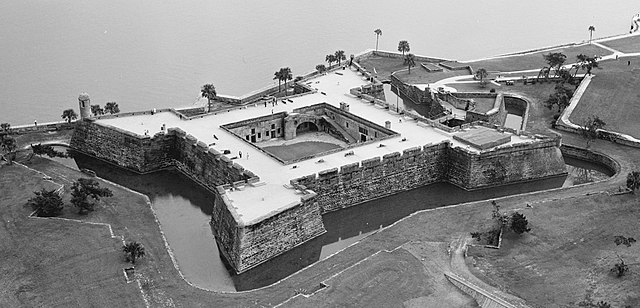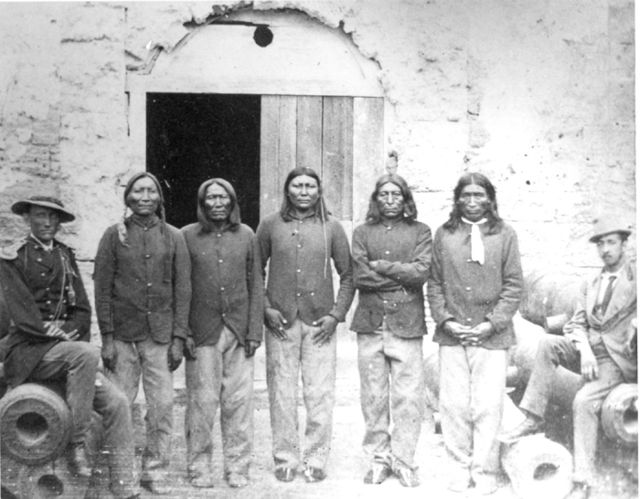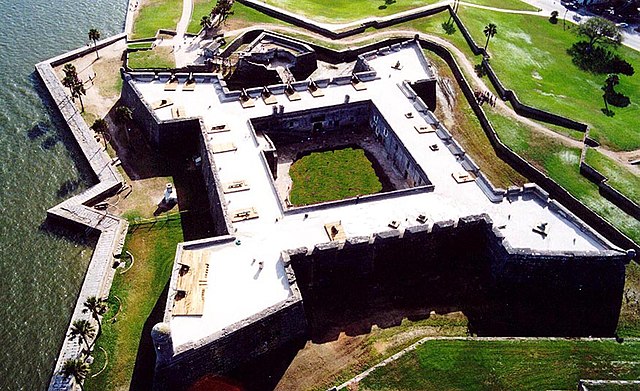Castillo De San Marcos National Monument Camping
notifications Text me when there's a cancellation at Castillo De San Marcos National Monument









Castillo De San Marcos National Monument
Built by the Spanish in St. Augustine to defend Florida and the Atlantic trade route, Castillo de San Marcos National Monument preserves the oldest masonry fortification in the continental United States and interprets more than 450 years of cultural intersections.
The Castillo de San Marcos (Spanish for “St. Mark’s Castle”) is the oldest masonry fort in the continental United States; it is located on the western shore of Matanzas Bay in St. Augustine, Florida.
It was designed by the Spanish engineer Ignacio Daza, with construction beginning in 1672, 107 years after the city's founding by Spanish Admiral and conquistador Pedro Menéndez de Avilés, when Florida was part of the Spanish Empire. The fort's construction was ordered by Governor Francisco de la Guerra y de la Vega after a raid by the English privateer Robert Searles in 1668 that destroyed much of St. Augustine and damaged the existing wooden fort. Work proceeded under the administration of Guerra's successor, Manuel de Cendoya in 1671, and the first coquina stones were laid in 1672. The construction of the core of the current fortress was completed in 1695, although it would undergo many alterations and renovations over the centuries.
When Britain gained control of Florida in 1763 pursuant to the Treaty of Paris, St. Augustine became the capital of British East Florida, and the fort was renamed Fort St. Mark until the Peace of Paris (1783) when Florida was transferred back to Spain and the fort's original name restored. In 1819, Spain signed the Adams–Onís Treaty which ceded Florida to the United States in 1821; consequently, the fort was designated a United States Army base and renamed Fort Marion, in honor of American Revolutionary War hero Francis Marion. The fort was declared a National Monument in 1924, and after 251 years of continuous military possession, was deactivated in 1933. The 20.48-acre (8.29 ha) site was subsequently turned over to the United States National Park Service. In 1942 the original name, Castillo de San Marcos, was restored by an Act of Congress.
Castillo de San Marcos was attacked several times and twice besieged: first by English colonial forces led by Carolina Colony Governor James Moore in 1702, and then by English Georgia colonial Governor James Oglethorpe in 1740. However, possession of the fort has changed five times, all peaceful, among four different governments: Spain, 1695–1763 and 1783–1821, Kingdom of Great Britain, 1763–1783, and the United States, 1821–date (during 1861–1865, under control of the Confederate States of America). Owing to its strategic cannon placement and star-shaped design, the fort was never breached or taken by force throughout its various stages of sovereign ownership.
Under United States control the fort was used as a military prison to incarcerate members of Native American tribes starting with the Seminole—including the famous war chief, Osceola, in the Second Seminole War—and members of western tribes, including Geronimo's band of Chiricahua Apache. The Native American art form known as Ledger Art had its origins at the fort during the imprisonment of members of the Plains tribes such as Howling Wolf of the southern Cheyenne.
Although built in part by African slaves owned by the Spanish, the fort later served as one of the first entry points of fugitive slaves from British North America into Spanish Florida, where they were freed by the Spanish colonial authorities. This quickly led to the first free Black settlement in the future United States (Fort Mose, formed just north of St Augustine).
Ownership of the Castillo was transferred to the National Park Service in 1933, and, along with the nearby St. Augustine Historic District, has been a popular tourist destination ever since.
Read more about Castillo De San Marcos National Monument at Wikipedia
We can help! Many campsite reservations are cancelled daily. Just tell us when you’d like to camp at Castillo De San Marcos National Monument, and how long you want to camp for. We’ll text you when a suitable spot opens up!
Scan for cancellationsWhoops! Sometimes we make mistakes. Want to help improve the Castillo De San Marcos National Monument listing? Please suggest a correction.
Open to camping at other nearby parks? Here are a few other parks you'll find in the vicinity.

How was your visit to Castillo De San Marcos National Monument? Share your review of Castillo De San Marcos National Monument and help fellow nature-lovers make an informed decision.
Post a reviewTell us when, where, and how long you want to camp for. We’ll notify you (via SMS) when a suitable spot opens up at that campground—so you can nab that sold-out campsite reservation!